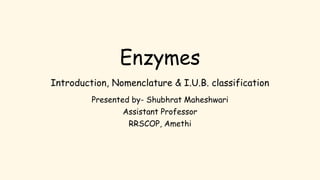
Enzymes(introduction,nomenclature and classification)
- 1. Enzymes Introduction, Nomenclature & I.U.B. classification Presented by- Shubhrat Maheshwari Assistant Professor RRSCOP, Amethi
- 2. Introduction 1. Enzymes are a substance produced by a living organism which acts as a catalyst to bring about a specific Biochemical reaction so also called as Bio-catalyst. 2. Enzymes are biological molecules (typically proteins) that significantly speed up the rate of virtually all of the chemical reactions that take place within cells. They are vital for life and serve a wide range of important functions in the body, such as aiding in digestion and metabolism. 3. Enzymes are made from amino acids, and they are proteins. When an enzyme is formed, it is made by stringing together between 100 and 1,000 amino acids in a very specific and unique order. The chain of amino acids then folds into a unique shape.
- 4. Properties of enzymes 1. Enzymes are protein macromolecule. 2. They are organic biocatalyst (simple or conjugated). 3. They require small quantity for the biological action. 4. Their activity depends on the temperature (optimized temp. 35℃-40℃) and changes in hydrogen ion concentration (pH). 5. They are specific for bonds or linkage like ester, or glycoside e.g. Esterase act on ester bond 6. They act on only one type of specific substrate (e.g. urease decompose urea).
- 5. Properties of enzymes 7. They always produce the same end products. 8. They are reusable. 9. Proenzymes are inactive before the start of reaction. 10. Some enzymes requires as cofactor for proper functioning. Cofactors are non-protein part derived from niacin, riboflavin etc. which is bound within the enzyme molecules. 11. They lower the activation of energy so reactions occur at mild temperature in all leaving cells. 12. Many enzymes are stereospecific e.g. L amino acid oxidase act only on the L. amino acid not on D-amino acid.
- 6. Nomenclature of Enzymes • The nomenclature of first discovered enzymes was named according to their sources by adding suffix - in like pepsin, trypsin etc. Enzyme acted upon the substrate • The molecule upon which enzyme acts is known as substrate. Naming of an enzyme by adding the suffix – ase in the name of the substrate which is catalyzed by the enzyme. • For example, enzymes catalyzing lipids were named lipases, nucleic acids as nucleases and so on. • A few of the names were even more specific like maltase (acting upon maltose), tyrosinase (tyrosine), sucrase (sucrose) etc.,
- 8. Nomenclature of Enzymes(contd.) Type of reaction catalyzed by enzyme : • The enzymes are highly specific to the reaction they catalyze. • Hence, this has been necessary in naming them by adding suffix- ase in the name of the reaction; • for example • hydrolases (catalyzing hydrolysis), • isomerases (isomerization), • oxidases (oxidation), • dehydrogenases (dehydrogenation), • transaminases (transamination), • Phosphorylases (phosphorylation) etc.,
- 9. Nomenclature of Enzymes(contd.) Substance that is synthesized : • A few enzymes have been named by adding the suffix –ase to the name of the substance synthesized, viz., fumarase that forms fumarate irreversibly from L-malate.
- 10. Enzyme classification (IUB Classification) • In 1961, International Union of Biochemistry (I.U.B.) used this criterion as a basis for the classification and naming of enzymes. Although complicated, the I.U.B. system is precise, descriptive and informative. • Enzymes are classified according to the type of reaction they catalyze. • According to International Union of Biochemistry and Molecular Biology (IUBMB) system, enzymes are classified into seven major classes. a. The reactions and the enzymes catalyzing them are divided into 7 major classes, each with 4 to 13 subclasses. b. Each enzyme name has two parts- the first part is the name of the substrate and the second part which ends in suffix – ase, indicates the type of the reaction catalyzed.
- 11. c. Each enzyme has been allotted a systemic code number called Enzyme Commission (E.C.) number. The E.C. number for each enzyme consists of a series of numbers at 4 places: - First digit represents the class- classifies the enzyme based on its reaction. - Second digit stands for the subclass- indicates the type of group involved in the reaction. - Third digit is the sub-subclass or subgroup- indicates substrate on which group acts. - Fourth digit gives the number of particular enzymes in the list- indicates the serial number of individual enzyme.
- 12. • For example – ➢ Thus E.C.2.7.1.1 represents class 2 (a transferase), subclass 7 (transfer of phosphate), sub-subclass 1 (an alcohol group as phosphate acceptor). The final digit denotes the enzyme, hexokinase or ATP: • D-hexose-6-phosphotransferase. This enzyme catalyzes the transfer of phosphate from ATP to the hydroxyl group on carbon 6 of glucose. ATP + D-hexose hexokinase ADP+ Hexose-6-phosphate
- 14. 7. Translocases catalyse the movement of ions or molecules hydron H+, inorganic anions, membrane or their separation within membranes. Inorganic cations etc.